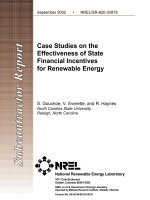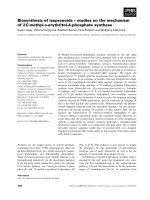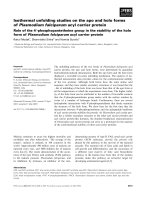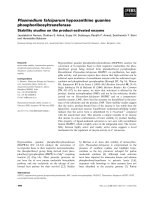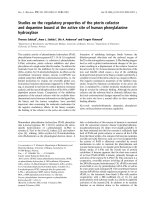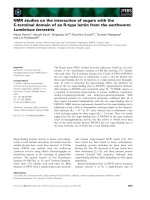Studies on the genetics basic foe themotolerace
Bạn đang xem bản rút gọn của tài liệu. Xem và tải ngay bản đầy đủ của tài liệu tại đây (5.61 MB, 209 trang )
Studies on the Genetic Basis for Thermotolerance in
Arabidopsis thaliana
A thesis submitted to University of Glasgow for the degree of M.Sc
Agustina Dwi Retno Nurcahyanti
February, 2009
Division of Plant Science
Faculty of Biomedical and Life Sciences
University of Glasgow
i
Abstract
Vast tracts of land are available for arable food production but much of this is
located in hot, arid regions. For crops to thrive in these conditions they will need
to show improved drought tolerance and also improved thermotolerance as low
water availability reduces transpiration resulting in increased leaf temperatures.
Identification of traits and genes involved in drought tolerance has been one of the
major areas of plant research over the last decade, but thermotolerance has
received little attention. In this study two approaches were used to identify the
genetic basis for improved thermotolerance in the model plant Arabisopsis thaliana.
In one set of experiments a gain-of-function heat stress screen (44 oC for 3 hours)
was performed on a collection of Activation Tagged lines where individual plants
were engineered to transcriptionally activate random sequences in the
Arabidopsis genome. Preliminary experiments confirmed prior exposure to 37 oC
for 1-3 hours acclimates Arabidopsis so that it survives better a subsequent heat
stress event.
A total of ~14,600 lines were screened and three mutants were
isolated; secondary screens confirmed their improved thermotolerance phenotype,
but in subsequent generations one of the lines developed a hypersensitive
phenotype, another reverted to wild type, whilst the third retained its
thermotolererant phenotype.
This loss-of-phenotype through generations was
attributed to gene silencing events which are not uncommon in dominant
mutants. Further experiments on these three lines are now required to identify the
loci of the disrupted gene(s) in each of these lines.
In the other set of experiments transgenic lines carrying a construct designed to
constitutively express a MYB transcription factor were characterized. This MYB
has been shown to confer salinity tolerance in Arabidopsis, and transcript
profiling using cDNA microarrays had identified several sequences may be under
the control of this MYB.
Quantitative PCR (QRT-PCR) demonstrated that
i
compared with wild type MYB expression in the transgenic lines was over 500
times greater, and that transcript for a small heat shock protein AtHSP17.6, is 17
times more abundant. These transgenic lines were shown to have an improved
thermotolerance. Treatment of wild type plants with 5 x 10-4 M ABA increased the
expression of this MYB seven-fold, suggesting this transcription factor forms part
of the ABA-dependent pathway for the activation of abiotic stress responses in
Arabidopsis.
ii
Declaration
I declare that this thesis has been written in accordance with University
regulations and is less than 50,000 words in length. All work contained herein was
performed by the author unless otherwise stated.
Agustina Dwi Retno Nurcahyanti
February 2009
iii
Acknowledgement
First of all, I would like to express my sincere gratitude to Jesus Christ who has
given me strength and good health during my study in University of Glasgow and
to finish this thesis.
I would like to extend my gratitude to the Indonesian Ministry of Education for
the award of a “Beasiswa Unggulan” Scholarship.
My sincere gratitude is also rendered to my supervisor, Dr. Peter Dominy, for his
pleasant teaching and introducing me into the fascinating world of biology
knowledge and research; for his advice, support, and encouragement during my
research. My deepest indebtedness is also addressed to him especially for his
valuable support and contribution in this thesis.
My appreciation to all the members of Dr. Peter Dominy Lab Group; Jim Jardine
for his patience in listening to each story, Indieka for his dancing and time to teach
and chat, Scott Ramsay for his photographic and other enormous skills, and
Naeem for his entertainments. Thank you for providing an excitement, pleasant,
and humorous scientific environment to work and socialise with.
My thanks is also forwarded to Janet Laird, not only for teaching me quantitative
PCR but also for being a friend at the research. Also many thanks to Andrew Love
who has provided me advice and information about quantitative PCR.
I am also very grateful to Prof. Richard J Cogdell for his advice and
encouragement during my study in Glasgow University. Many thanks to Prof.
Kris Herawan Timotius, Leenawaty Limantara, Ph.D, and Dr. Martanto
Martosupono for the valuable suggestions and encouragement, past and present,
in Satya Wacana Christian University and in Glasgow University.
iv
Special thanks to Ita, Ratih, and Adhie for the lovely friendships, since in
Indonesia until finally we awarded the scholarship. A deeply thank for all
Indonesian friends for their constant love and support. Many thank for all friends
in Glasgow who have provided new pleasing experiences and delightful
friendship.
Finally and the most importantly, I would like to thank to my beloved family, my
father for his constant love and support, my mum who always be my soul, and my
gorgeous sister for her advice and encouragement. Many thanks for providing me
a lovely and happiness environment to grow up and to achieve every wish.
May Jesus bless them all.
Glasgow, February 2009
Agustina Dwi Retno Nurcahyanti
v
Abbreviations
ABA
Abscisic acid
abi
ABA insensitive
A.U.
Arbitrary unit
AOS
Activated oxygen species
AP2
Anthocyanin pigment 2
bZIP
Basic-region leucine zipper protein
CaM
Calmodulin
CBF
Calcium binding factor
CDPK
Calcium dependent protein kinase
DNA
Deoxyribonucleic acid
DRE
Dehydration-responsive element
EREBP
Ethylene-responsive element binding protein
ERF
Ethylene responsive factor
GPCR
G-protein coupled receptor
HSF
Heat shock transcription factor
HSP
Heat shock protein
InsP
Inositol phosphates
LEA
Late embryogenesis-abundant
MAPK
Mitogen activated protein kinase
MS
Mirashise and Skoog
OTS
Overly tolerant to salt
vi
PKS
Protein kinase
PS
Photosystems
QRT-PCR
Quantitative reverse transcript polymerase chain reaction
RLK
Receptor-like kinase
RNA
Ribonucleic acid
ROS
Reactive oxygen species
SOS
Salt-overly-sensitive
SQR-TPCR
Semi-quantitative reverse transcript polymerase chain reaction
TE
Tris EDTA
TF
Transcription factor
w/v
weight per volume (expressed as percentage)
v/v
volume per volume (expressed as percentage)
vii
Table of Contents
Abstract
i
Declaration
iii
Acknowledgement
iv
Abbreviations
vi
Table of Contents
viii
Table of Figures
xiv
Table of Tables
xvii
CHAPTER 1
INTRODUCTION
1
1.1. Salinity and Heat Stress: A Worldwide Problem in Agriculture
1
1.1.1. Global Abiotic Stress
1
1.1.2. Crop Improvement through Biotechnology
2
1.2. Salt Tolerance Mechanism
5
1.3. Plant Response to Heat Stress
8
1.3.1. Morpho-anatomical and Phenotypic Responses
8
1.3.2. Physiological Responses
9
1.3.3. Molecular Responses
11
1.4. Regulation of Thermotolerance Mechanisms
12
1.5. Abiotic Stress Signal Transduction in Plants
15
1.5.1. ABA Dependent and ABA Independent Processes Regulate
Stress-Responsive Genes
18
1.5.2. Transcription Factor Involved in Stress Signal Transduction
1.6. MYB and HSP Transcription Factors
1.6.1. MYB
20
23
23
viii
1.6.2. HSP
26
1.7. Functional Analysis by Gene Mutation
31
1.7.1. Loss-of-Function Mutation
31
1.7.2. Gain-of-Function Mutation
32
1.8. Arabidopsis thaliana as a Plant Model
32
1.8.1. Arabidopsis thaliana
32
1.8.2. Arabidopsis Activation Tagged Lines
33
1.8.3. The Advantages of Arabidopsis Activation Tagged
35
1.9. Isolation and Characterization of Arabidopsis Activation Tagged Salt
Tolerant Mutants
35
1.10. The Aims and Objectives of this Study
37
CHAPTER 2
MATERIALS AND METHODS
39
2.1. Materials
39
2.1.1. Plant Material
39
2.1.2. Chemicals
39
2.1.3. Kits
40
2.2. Methods
40
2.2.1. Surface Sterilization of Seeds
40
2.2.2. Germination of Seeds and Heat Treatment for Wild Type and
Activation Tagged Lines of Arabidopsis thaliana
41
2.2.3. Germination of Seeds and Heat Treatment for p35S:AtMYB64
Transgenic Lines
43
2.2.4. Genotyping Mutant and Transgenic Lines with Selectable Bar
Marker Gene
46
2.2.5. Isolation of Plant Genomic DNA
46
2.2.6. Isolation of Total RNA
46
ix
2.2.7. Quantification and Qualification RNA using Spectrophotometer
47
2.2.8. Denaturing Agarose Gel Electrophoresis of RNA
47
2.2.9. Isolation of PCR Product from Agarose Gel
48
2.2.10. TOPO Cloning of PCR Products
48
2.2.11. Colony PCR
48
2.2.12. Plasmid DNA Isolation
49
2.2.13. Semi-Quantitative
Reverse
Transcript
Polymerase
Chain
Reaction (SQRT-PCR)
49
2.2.14. Quantitative Reverse Transcript Polymerase Chain Reaction
(QRT-PCR)
51
2.2.15. Genotyping Arabidopsis Salt Tolerance Mutants using PCR
55
2.2.16. Statistical Analyses
55
CHAPTER 3
GENETIC SCREEN OF ARABIDOPSIS ACTIVATION TAGGED LINES
FOR THERMOTOLERANCE
57
3.1. Introduction
57
3.2. Weigel Arabidopsis Activation Tagged Lines
57
3.3. Screen of Wild Type Arabidopsis thaliana for Thermotolerance
58
3.4. Screen of Non-Acclimated Arabidopsis Activation Tagged Lines for
Thermotolerance
61
3.5. Characterization of Thermotolerance in Lines N23814A, N23816A, and
N23822A
66
3.6. Discussion
68
x
CHAPTER 4
ANALYSIS OF THERMOTOLERANCE IN p35S:AtMYB64 TRANSGENIC
LINES
70
4.1. Introduction
70
4.2. Quantitative Reverse Transcription PCR (QRT-PCR)
71
4.2.1. Definition of QRT-PCR
71
4.2.2. General Method of QRT-PCR
71
4.2.3. Experimental Design
75
4.3. Genotyping p35S:AtMYB64 Lines using Selectable Bar Marker Genes
4.4. The
Plate-Based
Phenotypic
Thermotolerance
Analysis
76
of
p35S:AtMYB64 Transgenic Lines
77
4.5. Analysis of the Expression of Stress Responsive Genes in Heat
Acclimated p35S:AtMYB64 Transgenic and Col-0 WT Arabidopsis
Lines.
81
4.5.1. Introduction
81
4.5.2. Semi Quantitative Reverse Transcription Polymerase Chain
Reaction (SQRT-PCR) Analysis
81
4.5.3. Quantitative Reverse Transcription Polymerase Chain Reaction
(QRT-PCR) Analysis.
82
4.6. Characterization of The AtMYB64 Transcription Factor Signalling
Pathway
96
4.6.1. Introduction
96
4.6.2. Semi Quantitative Reverse Transcription Polymerase Chain
Reaction (SQRT-PCR) Analysis
97
4.6.3. Quantitative Reverse Transcription Polymerase Chain Reaction
(QRT-PCR) Analysis
98
4.7. Discussion
101
xi
CHAPTER 5
GENERAL DISCUSSION
104
5.1. Introduction
104
5.2. Genetic
Screen
of
Arabidpsis
Activation
Tagged
Lines
for
Thermotolerance
5.2.1. Genetic
Screen
104
of
Wild
Type
Arabidopsis
thaliana
for
Thermotolerance
106
5.2.2. Genetic Screen of Arabidopsis Activation Tagged Lines for
Thermotolerance
107
5.2.3. Partial Loss of Thermotolerance Phenotype in M3 Generation
5.3. Analysis of Thermotolerance in p35S:AtMYB64 Transgenic Lines
109
111
5.3.1. Actin-2 Chosen as Endogenous Control
111
5.3.2. The Abundance of AtMYB64 in Heat Acclimated Plants
113
5.3.3. The Abundance of HSPs Family in Heat Acclimated Plants.
117
5.3.4. The Abundance of Calmodulin 7 in Heat Acclimated Plants.
120
5.3.5. The Role of ABA in Activation of AtMYB64 Transcription Factor
124
5.3.6. Indication of Interaction between Temperature and Abscisic Acid
(ABA) in Regulation of AtMYB64
126
APPENDICES
127
Appendix 1 - Growth Media
127
Appendix 2 - Statistic Analysis
128
Table 1.
Statistic Analysis for Genetic Screen Wild Type Arabidopsis
thaliana for Thermotolerance
Table 2.
Statistic Analysis for Characterization of Thermotolerance in
Lines N23814A, N23816A, and N23822A
Table 3.
128
138
Statistic Analysis for AtMYB64 Transgenic Line Plate-Based
Phenotype Thermotolerance Analysis
xii
143
Table 4.
Statistic Analysis for AtMYB64 Abundance
145
Table 5.
Statistic Analysis for HSP17.6 (At5g12020) Abundance
150
Table 6.
Statistic Analysis for HSP17.6A (At5g12030) Abundance
154
Table 7.
Statistic Analysis for HSP70 Abundance
157
Table 8.
Statistic Analysis for HSP101 Abundance
160
Table 9.
Statistic Analysis for Calmodulin 7 Abundance
163
Table 10. Statistic Analysis for AtMYB64 Abundance in ABA-Treated
Plants
166
Appendix 3 - Analysis of Chi-Square Test for Bar Gene Selection
169
Table 1. Bar Gene Selection in 10 Seeds Stocks of T141 Transgenic Lines
169
Table 2. Bar Gene Selection in 18 Seeds Stocks of T127 Transgenic Lines
170
Appendix 4 - Relationship of R2R3 MYB Family in Arabidopsis thaliana
173
REFERENCES
174
xiii
Table of Figures
Figure 1.1.
Flow Chart of Stress Systems Biology
4
Figure 1.2.
A Simplified View of Abiotic Stress Tolerance Network in
Plants
5
Figure 1.3.
Heat Stress Sensing in Plants
14
Figure 1.4.
Generic Pathway for the Transduction of Abiotic Stress
Signals in Plants
Figure 1.5.
17
ABA Dependent and Independent Signal Transduction
Pathways for Osmotic Stress in Plant Cells
19
Figure 1.6.
Structure of smHSP16.9 Dodecamer in Wheat
29
Figure 1.7.
Construction and Fold of the smHSP16.9 Wheat Subunits
30
Figure 1.8.
Arabidopsis thaliana
33
Figure 1.9.
The pSKI015 Vector Used to Transform Arabidopsis
Activation Tagged Lines
34
Figure 1.10. Identification of Activation Tagged Insertion Site within JP5
Figure 2.1.
Germination condition of seven-day-old seedlings for Col-0
WT and Activation Tagged lines before heat treatment
Figure 2. 2.
36
41
Germination condition of seven-day-old seedlings of M2
putative thermotolerant mutant isolated from Arabidopsis
Activation Tagged (A) compared with Col-0 WT (B) before
heat exposure treatment
Figure 2. 3.
Germination
condition
43
of
seven-day-old
seedlings
of
p35S:AtMYB64 transgenic lines (B) compared with Col-0 WT
(A) before exposed to heat acclimation
Figure 2. 4.
44
Germination condition of fourteen-day-old seedlings of
p35S:AtMYB64 transgenic lines before exposed to heat
acclimation
45
xiv
Figure 2. 5.
CAS-3200
Corbett
Software
Robotic
Used
in
Sample
Preparation for QRT-PCR Analysis
Figure 3. 1.
54
Percentage Survival of Acclimated and Non Acclimated
Arabidopsis
Col-0
WT
Seedlings
Exposed
to
High
Temperatures
Figure 3. 2.
60
Primary Screen of Arabidopsis Activation Tagged Lines for
Heat Tolerant Mutants
Figure 3. 3.
62
Secondary Screen of Putative Thermotolerant Arabidopsis
Activation Tagged Mutants
Figure 3. 4.
63
Percentage Survival of Col-0 WT and M3 Putative
Thermotolerant Mutants
67
Figure 4. 1.
Principle of QRT-PCR Detection
72
Figure 4. 2.
Melt Curve Analysis of QRT-PCR Products
73
Figure 4. 3.
TaqMan Probe Chemistry Mechanism
74
Figure 4. 4.
The Effect of Heat Stress on Heat Acclimated and NonAcclimated
p35S:AtMYB64
Transgenic
and
Col-0
WTArabidopsis Lines
Figure 4. 5.
SQRT-PCR
79
Assessment
of
Actin-2
Abundance
in
p35S:AtMYB64 Transgenic and Col-0 WT Arabidopsis Lines
After Heat Acclimation
Figure 4. 6.
82
Variations in ‘Internal Standard’ Sequence Concentration in
Heat Acclimated p35S:AtMYB64 Transgenic and Col-0 WT
Arabidopsis Lines
Figure 4. 7.
85
Variation of Actin-2 Abundance in Heat Acclimated
p35S:AtMYB64 Transgenic and Col-0 WT Arabidopsis Lines
Figure 4. 8.
87
QRT-PCR of AtMYB64 Abundance in Heat Acclimated
p35S:AtMYB64 T127 Transgenic and Col-0 WT Arabidopsis
Lines
89
xv
Figure 4. 9.
QRT-PCR of 4 Heat Shock Proteins (HSPs) Abundance in
Heat Acclimated p35S:AtMYB64 T127 Transgenic and Col-0
WT Lines
92
Figure 4. 10. QRT-PCR of Calmodulin 7 (CaM7) Abundance in Heat
Acclimated p35S:AtMYB64 T127 and Col-0 WT Arabidopsis
Lines
95
Figure 4. 11. SQRT-PCR Analysis of The Expression of AtMYB64 in Col-0
WT Treated with ABA
97
Figure 4. 12. Variations in Potential QRT-PCR Normalization Sequences
in ABA-treated Arabidopsis Seedlings
99
Figure 4. 13. QRT-PCR of AtMYB64 Abundance in Col-0 WT Arabidopsis
Seedlings Treated with ABA
Figure 5. 1.
Figure 5. 2.
100
The Punnet Square: Visual Summary of a Cross between a
Wild Type and Homozygous Dominant Mutant
108
Ca2+ -CaM-mediated Signal Transduction in Plants
122
xvi
Table of Tables
Table 1.1.
Transport Processes that Contribute to Salinity Tolerance in
Plants
Table 1.2.
Table 1.3.
7
Transcription Factor Families Involved in Stress-Responsive
Gene Regulation in Plants
22
The Major Plant Heat Shock Protein Family
27
Table 2. 1. The Primers used for Semi-Quantitative Reverse Transcription
PCR
50
Table 2. 2. Primer Sequences of Six Heat Acclimation Responsive Genes
Used for Quantitative Reverse Transcription PCR
52
Table 3. 1. Primary and Secondary Screen of Activation Tagged Lines for
Thermotolerance.
64
Table 3. 2. Chi-Square Test of BASTA Segregation Analysis of the Most
Tolerant Lines Identified from The Secondary Screen.
65
Table 3. 3. Percentage Survival of Thermotolerant Mutants N23814A,
N23816A, and N23822A.
66
Table 4. 1. Percentage Surviving Seedlings of p35S:AtMYB64 Transgenic
and Col-0 WT Lines 5-Day-Post Heat Stress.
xvii
80
CHAPTER 1
INTRODUCTION
1.1. Salinity and Heat Stress: A Worldwide Problem in Agriculture
1.1.1. Global Abiotic Stress
The greatest challenge for humanity in the next few decades will be how to
increase and sustain arable production without degrading land. Land degradation
is proceeding rapidly. Therefore many countries will not be able to achieve
sustainable agriculture in the future. The Global Assessment of Land Degradation
(GLASOD) estimated that a total of 1964 million Ha have degraded, 910 million
Ha to at least a moderate degree (with significantly reduced productivity), and 305
million Ha strongly degraded (no longer suitable for agriculture). Based on these
data, water erosion was the most common problem, affecting almost 1,100 million
Ha.
Beside water erosion, the greatest cause of decreasing production in many
agriculture lands, particularly in arid and semi-arid areas, is increasing soil
salinization. Salinization occurs in irrigated areas, usually when inadequate
drainage causes salts to concentrate in the upper soil layers where plants root. It is
a problem mainly in the arid and semi-arid zones, where 10 to 50 percent of the
irrigated area may be affected. Salinization can cause yield decreases of 10 to 25
percent for many crops, and may prevent cropping altogether when it is severe. It
is estimated that 3 percent of the world’s agricultural land is affected. In East Asia,
however, the proportion is 6 percent and in South Asia is 8 percent. For the arid
and semi-arid tropics as a whole, 12 percent of agricultural land may be affected
(FAO, 2002).
Salinity also occurs through natural processes from the accumulation of salts over
long periods of time in the soil or groundwater. It is caused by two natural
processes: (1) the weathering of parent materials containing soluble salts and (2)
the deposition of oceanic salt carried in wind and rain. Salinization caused by
1
natural or human-induced processes also result in the accumulation of dissolved
salts in the soil water and subsequently inhibits plant growth (Oldeman et al.,
1991).
Beside the salinity problem, agronomist worldwide are also greatly concerned
with the threat of rising temperatures due to global warming which will impact on
achieving maximum output from crop plants. High surface temperatures are a
common problem faced by agriculture especially during periods of drought or in
many arid and semi-arid regions in the world. Normally, plants grow in
environments with sufficient water supply to maintain leaf temperatures at or
below air temperatures through transpiration. However, in arid areas or when the
plants are exposed to drought conditions, plants experience stomata closure and
reduced transpiration. As a consequence of reduced transpiration, leaf
temperatures increase above the temperature of the surrounding air and the
elevated temperatures may limit dry matter accumulation because of increased
respiration, reduced photosynthesis, and cellular damage (Burke, 2001). High
temperatures are frequently experienced in seedlings, which leads to reduction in
the yield (Zhu, 2002; Chakraborty & Tongden, 2005). In a study on kentucky
bluegrass, a combination of heat and drought stress significantly reduced root dry
weigh (Jiang and Huang, 2000). Kernel fresh and dry matter accumulation were
severely disrupted by the long-term heat stress (8 days at 35 0C) and did not
recover when transferred back to 25 0C, resulting in the abortion of 97% of the
kernels (Cheikh and Jones, 1994).
1.1.2. Crop Improvement through Biotechnology
To solve the salinity and other stress-associated problem, an understanding at the
mechanisms by which plants perceive environmental signals and transmit them
into activate adaptive responses is of fundamental importance. In addition, most
salinity problems arise in the arid and semi-arid zones where plants are also faced
with high leaf temperatures. Biotechnology and genetic modification of plants to
2
tolerate multi- environmental stresses would be a valuable development.
Knowledge about stress responses in plant is also vital for the continued
development of rational breeding programs as well as transgenic strategies for
developing improved crops.
Two common biotechnological approaches to understand and improve plant
stress tolerance are marker assisted selection (MAS) and genetic transformation.
These approaches have contributed greatly to better understanding of the genetic
and biochemical bases of plant-stress tolerance and led to the development of
plants with enhanced tolerance to abiotic stress. MAS has emerged as an effective
approach to improve plant stress tolerance (Foolad, 2005). The use of this
approach requires the identification of genetic markers that are correlated with
genes or QTLs affecting whole plant stress tolerance. Other common
biotechnological approaches, such as advanced genetic transformation techniques,
have provided a significantly a better understanding of the genetic and
biochemical bases of plant stress-tolerance. Significant progress has been made in
the identification of genes, proteins or compound that have a remarkable effect on
plant stress tolerance at the cellular or organismal level (Apse and Blumwald,
2002; Bohnert et al., 2006). Manipulation of the expression or production of the
identified genes, proteins, or compounds through transgenic approaches have
resulted in the development of plants with enhanced stress tolerance in different
plant species (Zhang et al., 2001). Progress has been made using analysis of
expressed sequences tags, analysis of global gene expressions, targeted or random
mutagenesis, and gain-of-function or mutant complementation (Cushman and
Bohnert, 2000; Xiong et al., 2001).
3
Allel
mining
Figure 1.1. Flow Chart of Stress Systems Biology
The chart connects the systems approach to the analysis of plant stress response
pathways with gene mining and the transfer of knowledge from models to crops.
Figure adapted from Bohnert et al. (2006).
The development of advanced biotechnology techniques may improve stress
tolerance in crops. This will result in increased productivity, leading to higher
incomes for producers, lower prices for consumers, reduced environmental impact
(particularly insecticides), new crop varieties for sustainable cultivation in
marginal areas, improved food security, and higher nutritional value (protein
quality, levels of vitamins and micronutrients, etc.; Burke, 2001; FAO, 2002; Wang
et al., 2003).
4
1.2. Salt Tolerance Mechanism
There are three aspects of salt tolerance in plants: homeostasis, detoxification, and
growth control (Figure 1.2.).
Figure 1.2. A Simplified View of Abiotic Stress Tolerance Network in Plants
The SOS pathway mediates ionic homeostasis and Na+ tolerance. Two primary
stresses, ionic and osmotic, cause damage and often result in secondary stress such
as oxidation. CBFs/DREB transcription factor mediate some of the stress protein
gene expression in response to secondary stresses caused by high salt
concentration, cold, drought, or abscisic acid (ABA). The ionic homeostasis,
osmotic homeostasis, and detoxification pathway are proposed to contribute
actively cell division and expansion regulation to control plant growth.
Figure adapted from Seaman (_).
5
Homeostasis is broken down into ionic and osmotic homeostasis (Munns
and Tester, 2008).
1.
Osmotic homeostasis
The major effect of osmotic stress in plants is a reduction in cell turgor pressure.
This impairs cell expansion in root tips and young leaves, and induces stomatal
closure. Stomatal closure prevents the acquisition of CO2 for photosynthesis, the
movement of nutrients ions from the soil to the shoot via the transpiration stream,
and transcriptional cooling. Further, osmotic stress in plants is usually more
apparent when plants enter the reproductive phase of growth (late spring, early
summer) and thus compromises yield (Abebe et al., 2003).
2.
Ionic homeostasis
a.
Na+ Exclusion
Under salt stress, there is ionic imbalance with excess sodium and chloride ions
having a deleterious effect on many cellular systems. By removing Na+ from the
transpiration stream, Na+ will not accumulate to toxic concentrations in leaves.
However, a failure to exclude Na+ from the shoot arises after days or weeks,
depending on the species, premature death of older leaves will occur (Munns and
Tester, 2008).
b. Tissue Tolerance
Tolerance at the tissue level involves partition of Na+ and Cl- at the cellular and
intracellular level to avoid toxic concentration within the cytoplasm, especially in
mesophyll cells. Toxicity occurs with time after the concentration of Na+ increase
to high concentration in older leaves.
6
Process
Involved
Sensing and
signalling in
roots
Photosynthesis
Candidate Gene
SOS3, SnRKs
ERA1, PP2C,
AAPK, PKS3
Osmotic Stress
Osmotic
Tolerance
Modification of
long-distance
signalling
Decrease
stomatal closure
Accumulation
of Na+ in shoots
HKT, SOS1
Increased
osmotic
adjustment
Accumulation
of Na+ in
vacuoles
NHX, AVP
Increased
osmotic
adjustment
Accumulation
of Na+ in
solutes
P5CS, OTS,
MT1D, M6PR,
S6PDH, IMT1
Increased
osmotic
adjustment
Ionic Stress
Na Exclusion
Tissue
Tolerance
Control of net
Control of
ion transport to
vacuolar
shoot
loading
Avoidance of
Delay ion
ion toxicity in
toxicity in
chloroplast
chloroplast
Reduced long
Reduce energy
distance
spent on Na+
transport of Na+ exclusion
+
Increased
sequestration of
Na+ intro root
vacuoles
Alteration of
transport
processes to
reduce Na+
accumulation
Increased
sequestration of
Na+ into leaf
vacuoles
Accumulation
of high
concentration of
compatible
solutes in
cytoplasm
Table 1.1.Transport Processes that Contribute to Salinity Tolerance in Plants
Source : Munns and Tester (2008).
7


